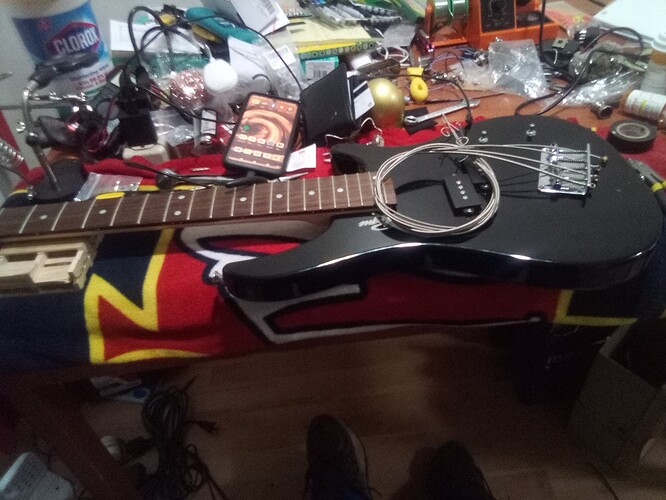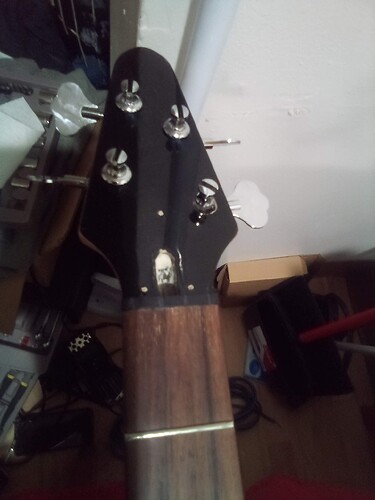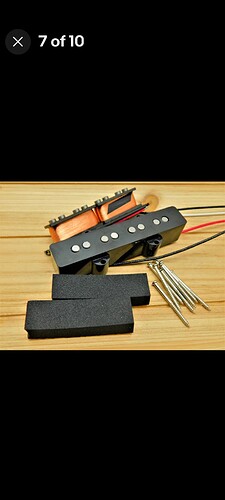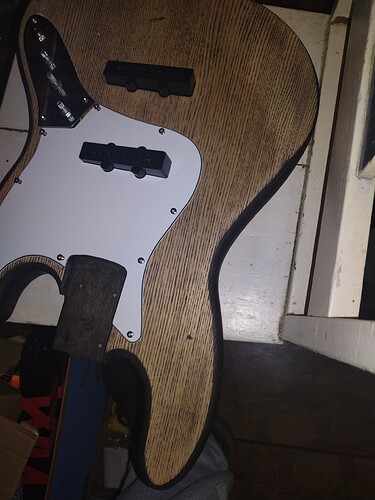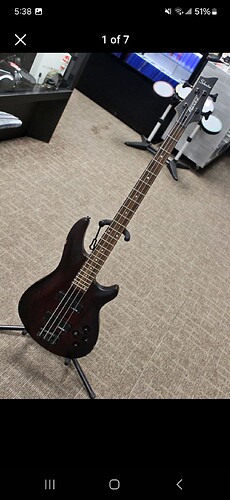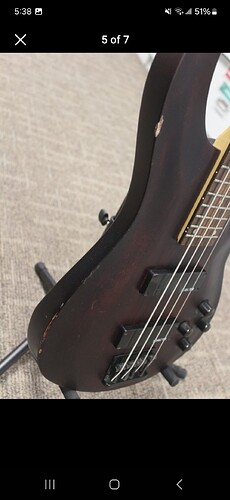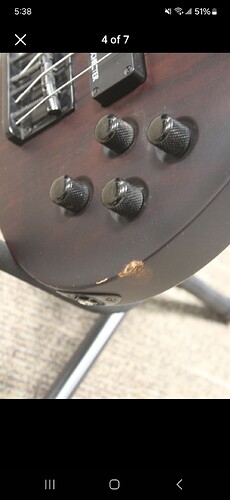I have an Amazon special dremel that has the name WEN. It is a good dremel tool. I believe that I paid $40 for it.
Those capacitors are not appropriate at all, really.
this value is only for active circuits, because of the output impedance of the pickups.
such a difference between the volume and the tone pot makes absolutly no sense, really.
I see another electrolytic cap near the jack socket, I don’t know what is the idea (maybe a virtual ground ?) but this should not be there on such a circuit.
A basic chinese one should be enough. I’ve used one for years before buying a real Dremel.
I’m trying to get the lowest tones from my bass. If I don’t like the sound I can always change it. Yes I did install a Cap by the output jack. I might just remove it from the output jack. Why is not appropriate using these big Caps?
I’ll have my jazz bass thumping.
for the reasons we discussed with @howard after you talked about those caps
Yeah. Specifically two reasons. First, electrolytic caps are polarized; they are only appropriate for DC current. Pickups generate AC current. This will simply shred the caps and they will only function for half the cycle.
Second, the value of the capacitor determines the cutoff frequency of the filter circuit, and the pot determines how much of the signal goes through it. The larger the cap, the lower the cutoff (and also I believe the steeper the cutoff but I could be wrong). Going beyond 0.100 or so will cut out so much signal that all that is left is a muddy thud. Going beyond .068 or so will sound simply bad IMO, and going beyond .047 will sound quite dark. I like .047 though.
Even the 1000 and 2000µF caps you are using will shift the cutoff frequency way way down into the subsonic; it would be basically acting as a mute and for all intents be shunting the entire signal to ground, and that’s if you had a non-electrolytic cap. I actually think the only reason your bass makes sound at all is that some combination of the other wiring is also wrong by coincidence.
Honestly it doesn’t sound muddy at all. I understand and truly appreciate what you are saying. I’m experimenting with different values of Pots and Caps and resistors. I don’t really play as much. Nor do I practice as much as I really should. I could definitely understand if I played it all the time especially when giving. How the Caps I’m using at the moment would cause premature failure. But, honestly I’m learning about basses and guitars and eventually becoming a Luthier n my own basses and guitars. I’ve only been repairing basses and guitars for a little over a year now.
This Rogue LX205B is my second Rogue bass I’ve ever owned. But it was the first bass I ever desoldered and soldered different pots, etc. Then I replaced the power entry module in my SWR LA15. I learned a valuable lesson. Working on my amp. That capacitors store electrons. I’m extremely grateful that it has been powered up in a few years. But, if my work destroys my stuff. Then I’m out of bass. This jazz bass I’m building. I don’t know what it’s going to sound like, and do to the electronics. I’m sorry if what I’m is I conventual. But, I have to learn The hard way. As long as I don’t destroy anything else, but my own property. I’ll learn more from my mistakes and screwups. Than actually sitting in a classroom. That’s why I’ve joined BassBuzz. Is seeking advice, and constructive criticism.
P.S. all my basses and guitars will always make sound, and sound really ![]() .
.
These are the pickups I’ll be using.
I still have the cheaply original pickups. I’ve just got done staining the neck.
I definitely apologize I thought I uploaded a picture of my 5 string. Instead I uploaded pictures of my Generic Pbass. Which just happens to be my third Rogue bass I’ve owned.
Here’s the neck with a coat of prestain and ebony stain. After it dries for a day or two or more. I’m going to start with 240 grit sandpaper and work my way up to 3000 grit sandpaper. Then put a final coat on. Before I open the gloss polyurethane for protection. The body of my generic jazz bass.
Why did you put a capacitor on the jack?
And also because the 1M tone pot is much bigger than the 25k volume pot (which is way too low), which makes the tone filter some kind of ON/OFF switch.
And also the internal resistance of a big electrolytic cap is awful for an audio circuit. You never see such a cap in an audio path.
Yeah seriously these caps are not contributing to tone. If anything they are preventing it.
Additionally, electrolytic caps can pop from as little as one volt anti-polarity bias. It won’t be “gradual” wear and tear if it happens.
Finally, the cap on the jack does literally nothing except potentially shunt tone to ground through its internal resistance. This will be all tone, not just the high parts - that cap will not act as a filter.
The tone caps do not boost signal in any way (except for a small bump at the resonant peak, which will be at the cutoff frequency); all they do is serve to remove high end tone. It is important that they be in a pretty small range to do anything musical.
To sum up with pratical data : in a passive instrument, the pots (volume and tone) should be in the 100k to 1M range, most often 250k or 500k.
The tone cap should be in the 10nF to 100nF range, most often 22nF to 68nF. I find that 22nF is a little bit too high in cutoff frequency for a bass (but it’s perfect for most guitars) and the ideal “standard” value is 47nF. You can go up to 68nF or even 100nF if you want your filter to go into the very dark territory.
The capacitor must me a non-polarized one. There is no need for an expensive 600v polypropylene cap like an Orange Drop, it’s just some kind of weird fashion. A standard 63v polyester (or polypropylene, if you really want) works perfectly fine and is actually the appropriate choice.
I should copy this little sum up because I’m sure we’ll have to explain all that again in the future ![]()
Yeah probably want to add that the pots should be roughly balanced for most people, such as 2x 500k. And nice safe tone cap values are (as you said) .033 and .047uF (33 and 47nF). More than .068uF and it will start to get really dark, and get above 0.1uF and you’re gonna be in the mud zone.
At some point likely still well below 1uF the cutoff will be below 20Hz and the bass won’t sound like much at all.
I read about it. I believe it was Lindy Fralin. I was reading about it. I have removed it from the output jack. I’ve also removed the two push pull pots. Now I have an A25K pot, a B100K blend pot, and a B1M pot. Except I need to swap the A25K pot with the B1M pot. Anyway I’m just curious and experimenting with the different value potentiometers, capacitors, resistors, diodes and transistors. Evil Genius Creations is my thing. Eventually it will become my business.
Have you had a look at some wiring diagrams and done a bit of reading?
With the exception of OMG mode on some G&Ls. That’s a split coil MM-style humbucker with one coil output in series with a 1000 μF cap.
Well that’s accomplishing a different function of course (tone caps are in parallel across the signal path and ground, which I am sure you know).
So a local pawn shop has this schecter for $300 cad but I could probably get them down a bit. How hard would it be to make it look pretty again? It plays but I haven’t checked it out yet.
It’s pretty now ![]()
